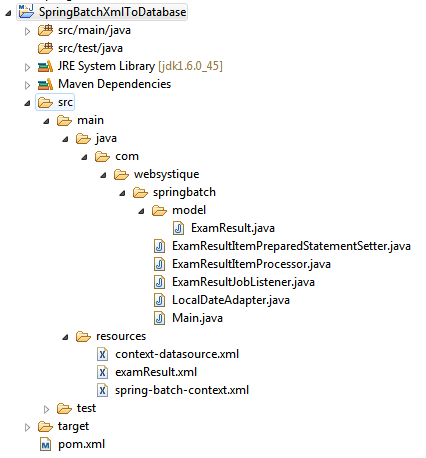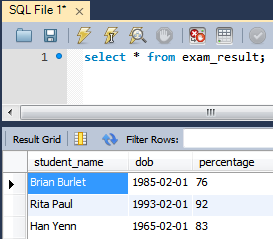In this post we will learn about how to use Spring Batch to read an XML file using StaxEventItemReader and write to MySQL Database using JdbcBatchItemWriter. We will also witness the usage of JobExecutionListener and itemProcessor. Let’s get going.
- Spring Boot+AngularJS+Spring Data+Hibernate+MySQL CRUD App
- Spring Boot REST API Tutorial
- Spring Boot WAR deployment example
- Secure Spring REST API using OAuth2
- Spring Boot Introduction + Hello World Example
- AngularJS+Spring Security using Basic Authentication
- Secure Spring REST API using Basic Authentication
- Spring 4 Caching Annotations Tutorial
- Spring 4 Cache Tutorial with EhCache
- Spring 4 MVC+JPA2+Hibernate Many-to-many Example
- Spring 4 Email Template Library Example
- Spring 4 Email With Attachment Tutorial
- Spring 4 Email Integration Tutorial
- Spring MVC 4+JMS+ActiveMQ Integration Example
- Spring 4+JMS+ActiveMQ @JmsLister @EnableJms Example
- Spring 4+JMS+ActiveMQ Integration Example
- Spring MVC 4+Spring Security 4 + Hibernate Integration Example
- Spring MVC 4+Apache Tiles 3 Integration Example
- Spring MVC 4+AngularJS Example
- Spring MVC 4+AngularJS Routing with UI-Router Example
- Spring MVC 4 HelloWorld – Annotation/JavaConfig Example
- Spring MVC 4+Hibernate 4+MySQL+Maven integration example
- Spring 4 Hello World Example
- Spring Security 4 Hello World Annotation+XML Example
- Hibernate MySQL Maven Hello World Example (Annotation)
- TestNG Hello World Example
- JAXB2 Helloworld Example
- Spring Batch- Read a CSV file and write to an XML file
Following technologies being used:
- Spring Batch 3.0.1.RELEASE
- Spring core 4.0.6.RELEASE
- Spring jdbc 4.0.6.RELEASE
- Spring oxm 4.0.6.RELEASE
- MySQL Server 5.6
- Joda Time 2.3
- JDK 1.6
- Eclipse JUNO Service Release 2
Let’s begin.
Step 1: Create project directory structure
Following will be the final project structure:

What we will do here is read the XML file (src/main/resources/examResult.XML) and write it’s content to MySQL database.
Step 2: Create Database Table
Create a fairly simple table in MySQL database which maps to our domain model(and sufficient for this example).
create table EXAM_RESULT ( student_name VARCHAR(30) NOT NULL, dob DATE NOT NULL, percentage double NOT NULL );
Please visit MySQL installation on Local PC in case you are finding difficulties in setting up MySQL locally.
Now let’s add all contents mentioned in project structure in step 1.
Step 3: Update pom.xml to include required dependencies
Following is the updated minimalistic pom.xml
<project xmlns="http://maven.apache.org/POM/4.0.0" xmlns:xsi="http://www.w3.org/2001/XMLSchema-instance"
xsi:schemaLocation="http://maven.apache.org/POM/4.0.0 http://maven.apache.org/xsd/maven-4.0.0.xsd">
<modelVersion>4.0.0</modelVersion>
<groupId>com.websystique.springbatch</groupId>
<artifactId>SpringBatchXmlToDatabase</artifactId>
<version>1.0.0</version>
<packaging>jar</packaging>
<name>SpringBatchXmlToDatabase</name>
<properties>
<springframework.version>4.0.6.RELEASE</springframework.version>
<springbatch.version>3.0.1.RELEASE</springbatch.version>
<mysql.connector.version>5.1.31</mysql.connector.version>
<joda-time.version>2.3</joda-time.version>
</properties>
<dependencies>
<dependency>
<groupId>org.springframework</groupId>
<artifactId>spring-core</artifactId>
<version>${springframework.version}</version>
</dependency>
<dependency>
<groupId>org.springframework</groupId>
<artifactId>spring-oxm</artifactId>
<version>${springframework.version}</version>
</dependency>
<dependency>
<groupId>org.springframework</groupId>
<artifactId>spring-jdbc</artifactId>
<version>${springframework.version}</version>
</dependency>
<dependency>
<groupId>org.springframework.batch</groupId>
<artifactId>spring-batch-core</artifactId>
<version>${springbatch.version}</version>
</dependency>
<dependency>
<groupId>org.springframework.batch</groupId>
<artifactId>spring-batch-infrastructure</artifactId>
<version>${springbatch.version}</version>
</dependency>
<dependency>
<groupId>mysql</groupId>
<artifactId>mysql-connector-java</artifactId>
<version>${mysql.connector.version}</version>
</dependency>
<dependency>
<groupId>joda-time</groupId>
<artifactId>joda-time</artifactId>
<version>${joda-time.version}</version>
</dependency>
</dependencies>
<build>
<pluginManagement>
<plugins>
<plugin>
<groupId>org.apache.maven.plugins</groupId>
<artifactId>maven-compiler-plugin</artifactId>
<version>3.2</version>
<configuration>
<source>1.6</source>
<target>1.6</target>
</configuration>
</plugin>
</plugins>
</pluginManagement>
</build>
</project>
As we need to interact with db this time, we will use spring-jdbc support. Since we need to handle XML, we will use spring-oxm marshalling support. To interact with MySQL, we need mysql connector, and since we are also using joda-time for any date-time processing we might need, we will include that dependency as well.
Step 4: Prepare/review the input XML file and corresponding domain object /mapped POJO
Below is the input xml whose data we will be saving in MySQL database.
src/main/resources/examResult.xml
<?xml version="1.0" encoding="UTF-8"?> <UniversityExamResultList> <ExamResult> <dob>1985-02-01</dob> <percentage>76.0</percentage> <studentName>Brian Burlet</studentName> </ExamResult> <ExamResult> <dob>1970-02-01</dob> <percentage>61.0</percentage> <studentName>Renard konig</studentName> </ExamResult> <ExamResult> <dob>1993-02-01</dob> <percentage>92.0</percentage> <studentName>Rita Paul</studentName> </ExamResult> <ExamResult> <dob>1965-02-01</dob> <percentage>83.0</percentage> <studentName>Han Yenn</studentName> </ExamResult> </UniversityExamResultList>
And the mapped POJO with fields corresponding to the row content of above file:
com.websystique.springbatch.model.ExamResult
package com.websystique.springbatch.model;
import javax.xml.bind.annotation.XmlElement;
import javax.xml.bind.annotation.XmlRootElement;
import javax.xml.bind.annotation.adapters.XmlJavaTypeAdapter;
import org.joda.time.LocalDate;
@XmlRootElement(name = "ExamResult")
public class ExamResult {
private String studentName;
private LocalDate dob;
private double percentage;
@XmlElement(name = "studentName")
public String getStudentName() {
return studentName;
}
public void setStudentName(String studentName) {
this.studentName = studentName;
}
@XmlElement(name = "dob")
@XmlJavaTypeAdapter(type = LocalDate.class, value = com.websystique.springbatch.LocalDateAdapter.class)
public LocalDate getDob() {
return dob;
}
public void setDob(LocalDate dob) {
this.dob = dob;
}
@XmlElement(name = "percentage")
public double getPercentage() {
return percentage;
}
public void setPercentage(double percentage) {
this.percentage = percentage;
}
@Override
public String toString() {
return "ExamResult [studentName=" + studentName + ", dob=" + dob
+ ", percentage=" + percentage + "]";
}
}
We have annotated the properties with JAXB annotations in order to map the class properties to XML tags.Since we are using Joda-Time LocalDate API, we need to tell JAXB about how to perform the conversion.Below is the Adpater class for the same:
com.websystique.springbatch.LocalDateAdapter
package com.websystique.springbatch;
import javax.xml.bind.annotation.adapters.XmlAdapter;
import org.joda.time.LocalDate;
public class LocalDateAdapter extends XmlAdapter<String, LocalDate>{
public LocalDate unmarshal(String v) throws Exception {
return new LocalDate(v);
}
public String marshal(LocalDate v) throws Exception {
return v.toString();
}
}
Step 5: Create an ItemProcessor
ItemProcessor is Optional, and called after item read but before item write. It gives us the opportunity to perform a business logic on each item.In our case, for example, we will filter out all the items whose percentage is less than 75. So final result will only have records with percentage >= 75.
com.websystique.springbatch.ExamResultItemProcessor
package com.websystique.springbatch;
import org.springframework.batch.item.ItemProcessor;
import com.websystique.springbatch.model.ExamResult;
public class ExamResultItemProcessor implements ItemProcessor<ExamResult, ExamResult>{
@Override
public ExamResult process(ExamResult result) throws Exception {
System.out.println("Processing result :"+result);
/*
* Only return results which are equal or more than 75%
*
*/
if(result.getPercentage() < 75){
return null;
}
return result;
}
}
Step 6: Add a Job listener(JobExecutionListener)
Job listener is Optional and provide the opportunity to execute some business logic before job start and after job completed.For example setting up environment can be done before job and cleanup can be done after job completed.
com.websystique.springbatch.ExamResultJobListener
package com.websystique.springbatch;
import java.util.List;
import org.joda.time.DateTime;
import org.springframework.batch.core.BatchStatus;
import org.springframework.batch.core.JobExecution;
import org.springframework.batch.core.JobExecutionListener;
public class ExamResultJobListener implements JobExecutionListener{
private DateTime startTime, stopTime;
@Override
public void beforeJob(JobExecution jobExecution) {
startTime = new DateTime();
System.out.println("ExamResult Job starts at :"+startTime);
}
@Override
public void afterJob(JobExecution jobExecution) {
stopTime = new DateTime();
System.out.println("ExamResult Job stops at :"+stopTime);
System.out.println("Total time take in millis :"+getTimeInMillis(startTime , stopTime));
if(jobExecution.getStatus() == BatchStatus.COMPLETED){
System.out.println("ExamResult job completed successfully");
//Here you can perform some other business logic like cleanup
}else if(jobExecution.getStatus() == BatchStatus.FAILED){
System.out.println("ExamResult job failed with following exceptions ");
List<Throwable> exceptionList = jobExecution.getAllFailureExceptions();
for(Throwable th : exceptionList){
System.err.println("exception :" +th.getLocalizedMessage());
}
}
}
private long getTimeInMillis(DateTime start, DateTime stop){
return stop.getMillis() - start.getMillis();
}
}
Step 7: Add a custom Converter to handle the Date conversion
Note that since we are using Joda-time LocalDate which can not be mapped to MySQL date directly, we need to provide custom-logic to handle this conversion.Below is the class for this conversion.
com.websystique.springbatch.ExamResultItemPreparedStatementSetter
package com.websystique.springbatch;
import java.sql.PreparedStatement;
import java.sql.SQLException;
import org.springframework.batch.item.database.ItemPreparedStatementSetter;
import com.websystique.springbatch.model.ExamResult;
public class ExamResultItemPreparedStatementSetter implements ItemPreparedStatementSetter<ExamResult> {
public void setValues(ExamResult result, PreparedStatement ps) throws SQLException {
ps.setString(1, result.getStudentName());
ps.setDate(2, new java.sql.Date(result.getDob().toDate().getTime()));
ps.setDouble(3, result.getPercentage());
}
}
Step 8: Create Spring Context with job configuration
Create dataSource bean needed for database comminucation
src/main/resource/context-datasource.xml
<beans xmlns="http://www.springframework.org/schema/beans" xmlns:batch="http://www.springframework.org/schema/batch" xmlns:xsi="http://www.w3.org/2001/XMLSchema-instance" xsi:schemaLocation="http://www.springframework.org/schema/beans http://www.springframework.org/schema/beans/spring-beans-4.0.xsd"> <bean id="dataSource" class="org.springframework.jdbc.datasource.DriverManagerDataSource"> <property name="driverClassName" value="com.mysql.jdbc.Driver" /> <property name="url" value="jdbc:mysql://localhost:3306/websystique" /> <property name="username" value="myuser" /> <property name="password" value="mypassword" /> </bean> </beans>
Create the Spring context with batch job configuration.
src/main/resource/spring-batch-context.xml
<beans xmlns="http://www.springframework.org/schema/beans" xmlns:batch="http://www.springframework.org/schema/batch" xmlns:xsi="http://www.w3.org/2001/XMLSchema-instance" xsi:schemaLocation="http://www.springframework.org/schema/batch http://www.springframework.org/schema/batch/spring-batch-3.0.xsd http://www.springframework.org/schema/beans http://www.springframework.org/schema/beans/spring-beans-4.0.xsd"> <import resource="classpath:context-datasource.xml"/> <!-- JobRepository and JobLauncher are configuration/setup classes --> <bean id="jobRepository" class="org.springframework.batch.core.repository.support.MapJobRepositoryFactoryBean" /> <bean id="jobLauncher" class="org.springframework.batch.core.launch.support.SimpleJobLauncher"> <property name="jobRepository" ref="jobRepository" /> </bean> <!-- ItemReader which reads data from XML file --> <bean id="xmlItemReader" class="org.springframework.batch.item.xml.StaxEventItemReader"> <property name="resource" value="classpath:examResult.xml" /> <property name="fragmentRootElementName" value="ExamResult" /> <property name="unmarshaller"> <bean class="org.springframework.oxm.jaxb.Jaxb2Marshaller"> <property name="classesToBeBound"> <list> <value>com.websystique.springbatch.model.ExamResult</value> </list> </property> </bean> </property> </bean> <!-- ItemWriter which writes data to database --> <bean id="databaseItemWriter" class="org.springframework.batch.item.database.JdbcBatchItemWriter"> <property name="dataSource" ref="dataSource" /> <property name="sql"> <value> <![CDATA[ insert into EXAM_RESULT(STUDENT_NAME, DOB, PERCENTAGE) values (?, ?, ?) ]]> </value> </property> <!-- We need a custom setter to handle the conversion between Jodatime LocalDate and MySQL DATE --> <property name="ItemPreparedStatementSetter"> <bean class="com.websystique.springbatch.ExamResultItemPreparedStatementSetter" /> </property> </bean> <!-- Optional ItemProcessor to perform business logic/filtering on the input records --> <bean id="itemProcessor" class="com.websystique.springbatch.ExamResultItemProcessor" /> <!-- Optional JobExecutionListener to perform business logic before and after the job --> <bean id="jobListener" class="com.websystique.springbatch.ExamResultJobListener" /> <!-- Step will need a transaction manager --> <bean id="transactionManager" class="org.springframework.batch.support.transaction.ResourcelessTransactionManager" /> <!-- Actual Job --> <batch:job id="examResultJob"> <batch:step id="step1"> <batch:tasklet transaction-manager="transactionManager"> <batch:chunk reader="xmlItemReader" writer="databaseItemWriter" processor="itemProcessor" commit-interval="10" /> </batch:tasklet> </batch:step> <batch:listeners> <batch:listener ref="jobListener" /> </batch:listeners> </batch:job> </beans>
As you can see, we have setup a job with only one step. Step uses StaxEventItemReader to read the records, itemProcessor to process the record & JdbcBatchItemWriter to write the records in database. commit-interval specifies the number of items that can be processed before the transaction is committed/ before the write will happen.Grouping several record in single transaction and write them as chunk provides performance improvement. We have also shown the use of jobListener which can contain any arbitrary logic you might need to run before and after the job.
Step 9: Create Main application to finally run the job
Create a Java application to run the job.
com.websystique.springbatch.Main
package com.websystique.springbatch;
import org.springframework.batch.core.Job;
import org.springframework.batch.core.JobExecution;
import org.springframework.batch.core.JobExecutionException;
import org.springframework.batch.core.JobParameters;
import org.springframework.batch.core.launch.JobLauncher;
import org.springframework.context.ApplicationContext;
import org.springframework.context.support.ClassPathXmlApplicationContext;
public class Main {
@SuppressWarnings("resource")
public static void main(String areg[]){
ApplicationContext context = new ClassPathXmlApplicationContext("spring-batch-context.xml");
JobLauncher jobLauncher = (JobLauncher) context.getBean("jobLauncher");
Job job = (Job) context.getBean("examResultJob");
try {
JobExecution execution = jobLauncher.run(job, new JobParameters());
System.out.println("Job Exit Status : "+ execution.getStatus());
} catch (JobExecutionException e) {
System.out.println("Job ExamResult failed");
e.printStackTrace();
}
}
}
Running above program as java application, you will see following output
INFO: Job: [FlowJob: [name=examResultJob]] launched with the following parameters: [{}]
ExamResult Job starts at :2014-08-03T20:32:22.255+02:00
Aug 3, 2014 8:32:22 PM org.springframework.batch.core.job.SimpleStepHandler handleStep
INFO: Executing step: [step1]
Processing result :ExamResult [studentName=Brian Burlet, dob=1985-02-01, percentage=76.0]
Processing result :ExamResult [studentName=Renard konig, dob=1970-02-01, percentage=61.0]
Processing result :ExamResult [studentName=Rita Paul, dob=1993-02-01, percentage=92.0]
Processing result :ExamResult [studentName=Han Yenn, dob=1965-02-01, percentage=83.0]
ExamResult Job stops at :2014-08-03T20:32:22.763+02:00
Total time take in millis :508
ExamResult job completed successfully
Aug 3, 2014 8:32:22 PM org.springframework.batch.core.launch.support.SimpleJobLauncher run
INFO: Job: [FlowJob: [name=examResultJob]] completed with the following parameters: [{}] and the following status: [COMPLETED]
Job Exit Status : COMPLETED
And finally, check the EXAM_RESULT table in database.Below is the snapshot from database after this job.

Records are saved in database. You can see that records with percentage less than 75 are missing, thanks to ItemProcessor filtering.
That’s it.
Download Source Code
References
If you like tutorials on this site, why not take a step further and connect me on Facebook , Google Plus & Twitter as well? I would love to hear your thoughts on these articles, it will help improve further our learning process.